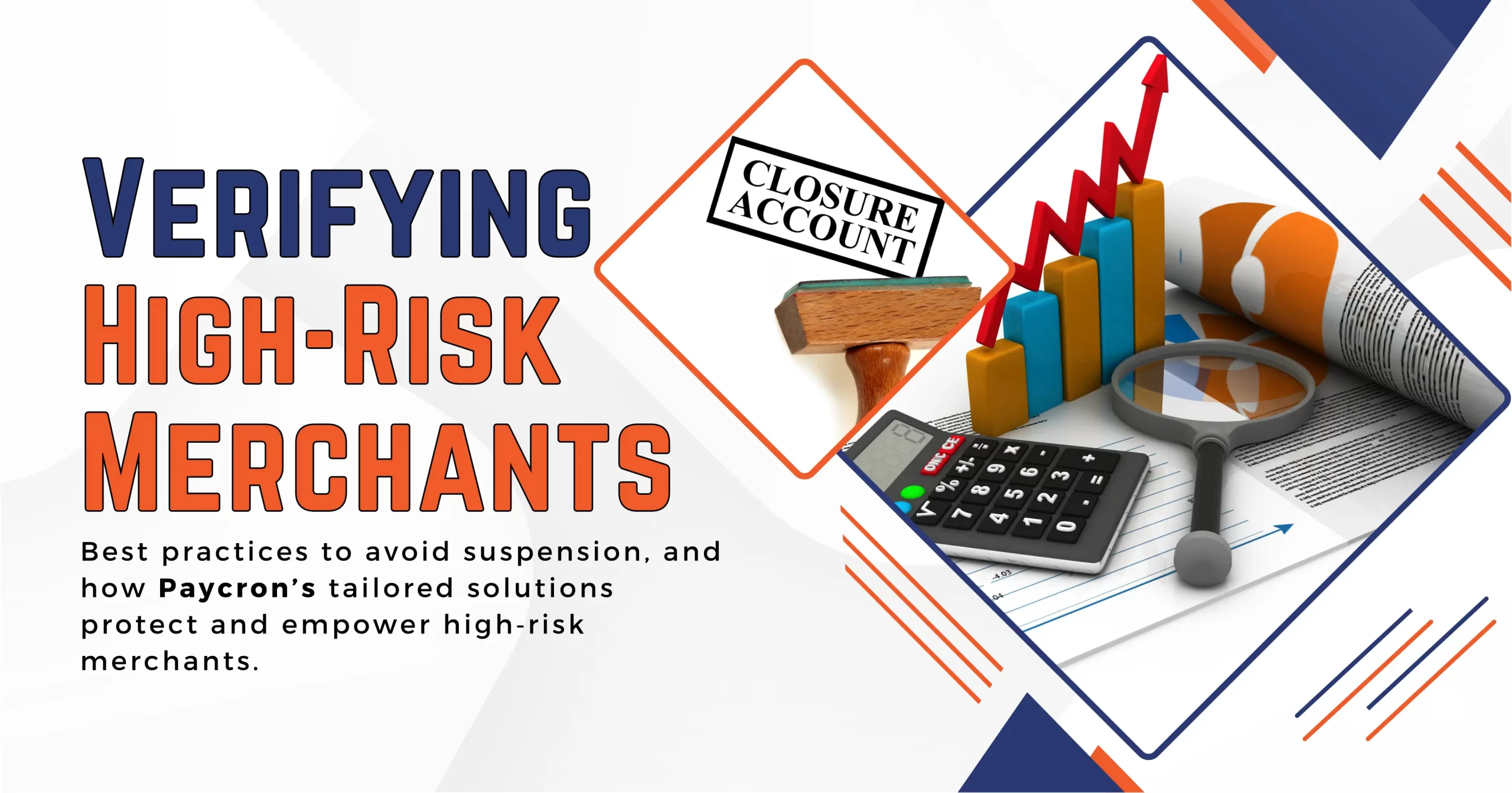
| June 19th, 2025 |
How Gateways Verify High-Risk Merchants & Avoid Suspensions!
Alright, so here’s the deal—if you’re running a business that falls into the so-called high-risk category, getting approved for a merchant account can feel like navigating a financial obstacle course. And for payment gateway providers? Well, they’re the ones who have to figure out whether high risk merchants are legit, sustainable, and safe to work with before they ever flip the switch and let them start accepting payments.
Now more than ever, this whole process matters—a lot. With stricter compliance regulations, rising fraud threats, and evolving tech standards (like PCI DSS v4.0.1 and global KYC/AML frameworks), gateways are under pressure to verify merchants with precision. And if you’re labeled “high-risk,” you’re automatically subject to more scrutiny.
But here’s the thing: just because your business is classified as high-risk doesn’t mean you’re doing anything wrong. It just means the potential for chargebacks, regulatory issues, or fraud is higher in your industry—and payment processors need extra layers of protection.
So in this post, we’re gonna break it all down:
- How do gateway providers verify high-risk business models?
- What can you, as a merchant, do to avoid account suspension?
- And how does Paycron step in as a reliable solution for businesses operating in complex, high-risk spaces?
Let’s unpack the full story—real insights, industry trends, and what you need to know to stay compliant and keep those payments flowing.
1. Rigorous Risk Assessment & Underwriting:
Well, first off, gateways kick things off with manual underwriting, especially for high-risk verticals like adult entertainment, travel, CBD, or subscription services. Unlike typical merchants, high-risk applicants must provide:
- Business documentation: licences, incorporation papers, articles of incorporation, personnel IDs—often 3-6 months of financials.
- Ownership transparency: details on ultimate beneficial owners, compliance with KYC/AML rules.
- Chargeback history: processors check ratios—anything over ~1% is a red flag.
They also dig into market and geographic risk: is the business located in a risky region? Are they selling internationally?
So yeah—lots of paperwork and manual review. But that’s just step one.
2. Advanced Fraud Tools & Transaction Monitoring:
Okay, beyond underwriting, gateways layer on fraud prevention tech:
- 3-D Secure 2.0, CVV, AVS, tokenization, encryption (P2PE), PCI DSS compliance—all standard.
- Real-time analytics, machine learning models like XGBoost or LightGBM for fraud detection, SMOTE-enhanced.
- Dynamic risk scoring and concept-drift detection to keep models current.
This isn’t just tech fluff—it’s helping reduce chargebacks (a major cause of account suspension).
3. Structure: Fees, Rolling Reserves & Contracts:
You know, high-risk accounts carry unique terms:
- Transaction fees often range 2.9–6% or higher.
- Rolling reserves typically hold 5–10% of transactions for 3–6 months.
- Contracts may include volume caps, longer terms, or reserve triggers.
These tools help protect gateways from sudden chargeback spikes or merchant flight.
4. Continuous Monitoring & Chargeback Defense:
Once active, merchants are under constant monitoring. Gateways use chargeback alerts and dispute resolution services to catch early warning signs. Some also offer real-time dispute guidance, helping merchants respond quickly to reduce chargeback ratios.
Regular account reviews can lead to new requirements—like increased reserves or stricter fraud flags—especially if thresholds are triggered.
Preventing High-Risk Merchant Account Suspension —
Being flagged high-risk is one thing; getting suspended is another—and that’s where a lot of businesses stumble.
A. Maintain Strong Chargeback Hygiene:
- Use clear refund policies, confirm customer satisfaction early.
- Implement real-time fraud checks: 3-D Secure, AVS/CVV, tokenization.
- Monitor disputes and respond promptly.
B. Ensure Ongoing Compliance:
- Stay current with PCI DSS v4.0.1 encryption, network security validation.
- Regular audits, documentation updates.
- Keep KYC/AML info up to date.
If compliance slips, that’s a fast track to suspension.
C. Communicate with Your Gateway:
- Proactively disclose changes: new products, pricing, or foreign market expansion.
- A responsive gateway can recommend risk adjustments before issues arise.
D. Build Financial Credibility:
- Strong personal and business credit profiles matter.
- Good financial transparency makes you look trustworthy.
Overall, it’s consistency and transparency that save you from surprise suspension.
Paycron’s Tailored Solution for High-Risk Businesses —
So, how does Paycron help? Well, they combine all those best practices into a practical offer:
- Tailored Account Setup:
Customized underwriting for industries like CBD, travel, subscription, adult, gaming—no cookie-cutter approach.
- Robust Fraud & Chargeback Tools:
Advanced fraud layers—3D Secure, AVS/CVV, encryption, dynamic ML risk scoring, and proactive dispute support.
- Flexible Payment Options:
Accept credit cards, eChecks, ACH, multi-currency—helpful for global merchants.
- Competitive Pricing & Reserves:
While fees are higher than low-risk, Paycron aims for competitive rates. Transparent deposits, reserve structures, feasible terms.
- Ongoing Support & Compliance:
Offers documentation help, chargeback prevention guidance, compliance reminders, and dedicated service—ensuring merchants stay ahead of issues.
In short, Paycron positions itself as that reliable partner—aiming to reduce friction and help high-risk merchants grow.
Market Trends & 2025 Insights —
- AI-driven fraud detection continues expanding.
- Global e-commerce is rising—nearly 24% of retail in 2026, so multi-currency and global compliance are critical.
- Stricter regulations around KYC/AML and beneficial ownership globally—manual underwriting is becoming mandatory.
- 3D Secure 2.0 adoption and PCI DSS v4.0.1 compliance is expected by almost every business for Stronger authentication.
These trends underscore how essential a Payment Gateway Provider like Paycron—focused on tech, compliance, and service—is for high-risk businesses to thrive.
Final Takeaways —
- Verification involves deep manual underwriting, documentation, KYC checks, fraud profiling.
- Tech tools—3-D Secure, P2PE, tokenization, ML—are non-negotiable for verifying transactions and avoiding chargebacks.
- Structured safeguards—fees, rolling reserves, clear contracts—shield the gateway and support merchant stability.
- Avoiding suspension means proactive compliance, transparency, managing chargebacks, communicating changes, strong credit.
- Paycron wraps it all together—custom support, multi-method payments, competitive terms, compliance guidance.
- Trends pushing forward: AI fraud tools, global transactions, strict regulation & compliance, enhanced authentication.
So yeah, that’s the low-down. If you’re running a high-risk merchants, it’s not just about finding a provider—it’s about working with someone who gets your space, offers robust tech, stays on top of compliance, and partners with you in growth. Paycron is carving out a strong reputation as precisely that.
